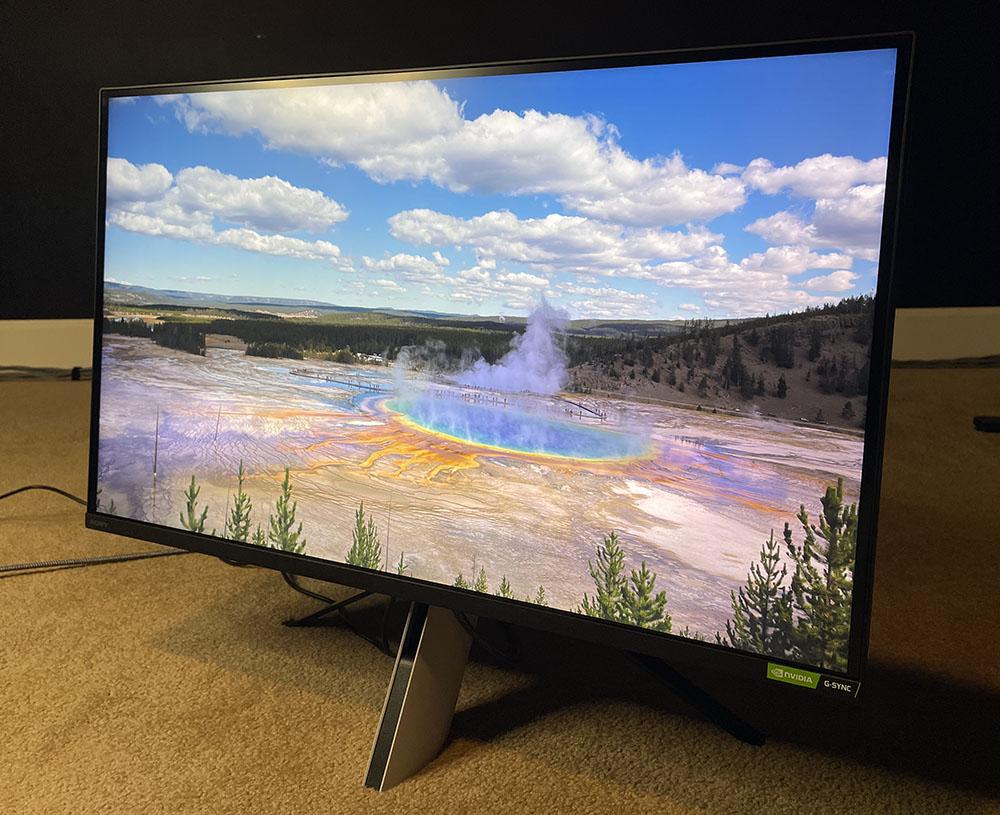Tom's Hardware Verdict
The Sony Inzone U27M90 is one terrific gaming monitor. It delivers a super-sharp and colorful picture that hits all the specs without calibration. Premium video processing makes it a great tool for PC or console gaming. And it comes in at an attractive price that undercuts the competition.
Pros
- +
Bright, sharp and contrasty image
- +
Full-array local-dimming backlight
- +
Excellent out-of-box color accuracy
- +
Premium quality video processing
- +
Unique styling that compliments the PS5
Cons
- -
No sRGB mode
Why you can trust Tom's Hardware
A Sony computer monitor? Now that’s something many enthusiasts aren’t old enough to remember. In the 1990s, Sony marketed a line of Trinitron CRT screens. Their main draw was that they only curved on the vertical axis, which meant they were the closest thing to a flat-screen you could buy at the time. NEC used the same picture tube in its Multisync line, of which I owned a 16-inch version. It was the best CRT monitor I ever owned.
Thirty years later, Sony is well known for its televisions and for the PlayStation 5 (PS5) gaming console. It was inevitable that it would jump into the gaming monitor party with something optimized for that product. The Inzone U27M90 is a 27-inch IPS panel with 4K resolution, 144 Hz, Adaptive-Sync, HDR, extended color AND (drum roll, please), a full-array backlight with 96 dimming zones. Priced at under $1,000, the Sony Inzone U27M90 is making a strong case for inclusion on our best 4K gaming monitor list!
Sony Inzone U27M90 Specs
| Panel Type / Backlight | IPS / W-LED |
| Row 1 - Cell 0 | Full-array w/96 dimming zones |
| Screen Size / Aspect Ratio | 27 inches / 16:9 |
| Max Resolution & Refresh Rate | 3840x2160 @ 144 Hz |
| Row 4 - Cell 0 | G-Sync: 1-144 Hz |
| Row 5 - Cell 0 | FreeSync: 48-144 Hz |
| Native Color Depth & Gamut | 10-bit / DCI-P3 |
| Row 7 - Cell 0 | HDR10, DisplayHDR 600 |
| Response Time (GTG) | 1ms |
| Brightness | 400 nits SDR |
| Row 10 - Cell 0 | 600 nits HDR |
| Contrast | 1,000:1 |
| Speakers | 2x 2w |
| Video Inputs | 1x DisplayPort 1.4 |
| Row 14 - Cell 0 | 2x HDMI 2.1 |
| Row 15 - Cell 0 | 1x USB-C |
| Audio | 3.5mm headphone output |
| USB 3.0 | 1x up, 3x down or None |
| Power Consumption | 32.7w, brightness @ 200 nits |
| Panel Dimensions WxHxD w/base | 24.2 x 16.1-18.9 x 7.2 inches (615 x 410-480 x 240mm) |
| Panel Thickness | 2.8 inches (70mm) |
| Bezel Width | Top/sides: 0.3 inch (8mm) |
| Row 22 - Cell 0 | Bottom: 0.6 inch (15mm) |
| Weight | 14.5 pounds (6.6kg) |
| Warranty | 3 years |
There is no shortage of 4K/144 Hz screens vying for gaming enthusiasts’ attention. With many models under $1,000, and available in 27, 28 and 32-inch sizes, you don’t have to look far for something that will compliment a PlayStation, Xbox or PC gaming system. However, Sony isn’t just offering a me-too product. The U27M90 is one of the least expensive 4K monitors to include a full-array local-dimming (FALD) LED backlight. With 96 zones, it delivers some killer HDR contrast. I measured over 22,000:1 in my tests and you can get similar performance for SDR content because the zone-dimming feature is available in all signal modes. Peak HDR output is rated at 600 nits, but I measured over 850 in testing.
According to my measurements, the color gamut covers just under 90% of DCI-P3, with excellent accuracy in two of the picture modes. I was also able to calibrate one of the Game modes to a high standard. The IPS panel’s native contrast is around 1,000:1, which is typical of the genre. But using the local dimming feature for SDR content pushed that to over 6,000:1 without any penalties like crushed detail or blown-out whites. Sony has tuned the U27M90 very well.
Video processing is given equally close attention. 144 Hz is supported over the DisplayPort 1.4 input, while two HDMI 2.1 ports accept up to 120 Hz (see HDMI vs DisplayPort to decide which is best). FreeSync Premium Pro and G-Sync compatibility were confirmed in my tests in both SDR and HDR modes. Nvidia does not yet have this monitor on its certified list, but since there’s a G-Sync logo on the front bezel, I suspect it’s only a matter of time. I also found an effective overdrive that reduces motion blur. The only omission here is a backlight strobe feature. Though I don’t consider that a big deal, some users prefer it over Adaptive-Sync. At 144 Hz, I find Adaptive-Sync to be more useful in keeping motion resolution high.
Gaming features include a set of aiming crosshairs, timers, a frame rate counter and an auto picture mode setting that detects the presence of a PS5 and sets the Game mode automatically. It is claimed to have lower input lag than the other modes. There’s a KVM feature with USB-C and traditional USB ports to support multiple systems like a PC and a PS5, which is enough to accommodate various peripherals like controllers, mice and keyboards. And if you want to control the U27M90 from the Windows desktop, Sony makes its Inzone Hub app available.
Assembly and Accessories for Sony Inzone U27M90
The U27M90 arrived in an unassuming brown carton that could have held any number of enterprise screens rather than a high-end gaming display. Retrieving the contents from the crumbly foam inserts, I immediately noticed the PS5 styling cues. This monitor has a unique look and feel. I had to root around in the box to find the two tiny screws that secured the base to the upright. I would have liked to see them captive in their holes rather than in a minuscule ziplock bag that can easily be lost. The power supply is a large brick. As I got an early sample, it didn’t have any other cables included.
Get Tom's Hardware's best news and in-depth reviews, straight to your inbox.
Product 360: Sony Inzone U27M90



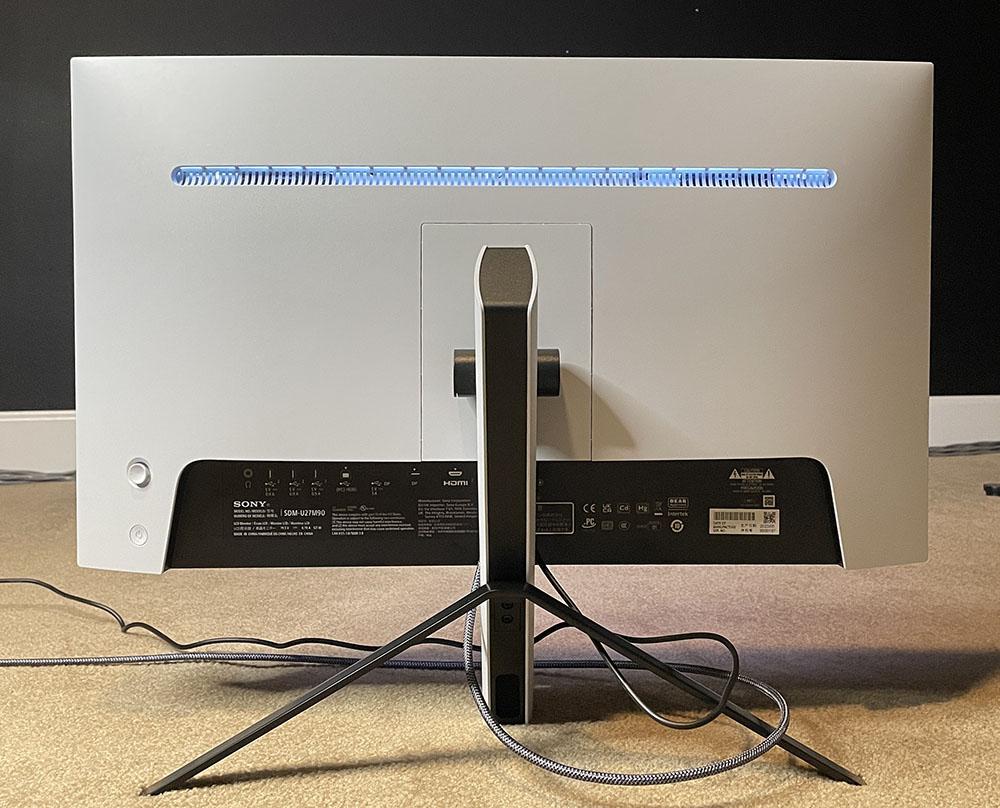


PS5 owners will love how well the U27M90 integrates with the futuristic look of their console. The same flowing white surfaces accented by recessed black transitions are found on the monitor. The back of the panel is entirely white with a large input panel at the bottom, inset in black with clear labels for the connections. There are two HDMI 2.1 ports, a DisplayPort 1.4, a USB-C, 3.5mm audio jack and three USB ports, one upstream and two down. USB-C can be used for video and accepts 4K signals up to 144 Hz with Adaptive-Sync and HDR.
Also in back is the U27M90’s lighting feature. It’s a long strip that glows softly in any one of 14 colors. You can also turn on a power LED, but it’s hidden around the lower right side, invisible from the front. If you reach around that corner, you’ll find a power toggle button and the OSD joystick. Under the panel-to-upright interface is a 100mm VESA mount with four bolts included to use with aftermarket solutions.
The stand is unique in my experience. The upright sits at an angle supported by two metal legs while the panel’s height adjustment of 70mm rides up and down as if on a ramp. It’s interesting because as you move the panel up, it gets farther away from you, not by much, but you might have to pull it forward to compensate. At maximum height, the panel is a little too low for vertical placement. I had to angle it upwards a bit to my eyepoint. The back tilt maxes out at 25 degrees and there is no swivel or portrait mode.
OSD Features: Sony Inzone U27M90
The U27M90’s OSD can be navigated with a handy joystick or by using Sony’s Inzone Hub app. The app covers the monitor’s menu system and can save configurations for individual games that include settings for the headphone audio.

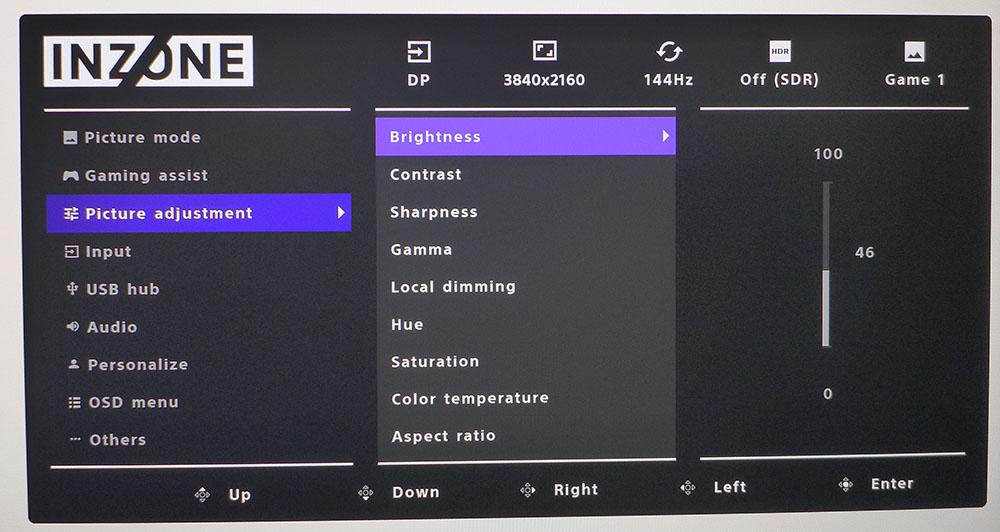

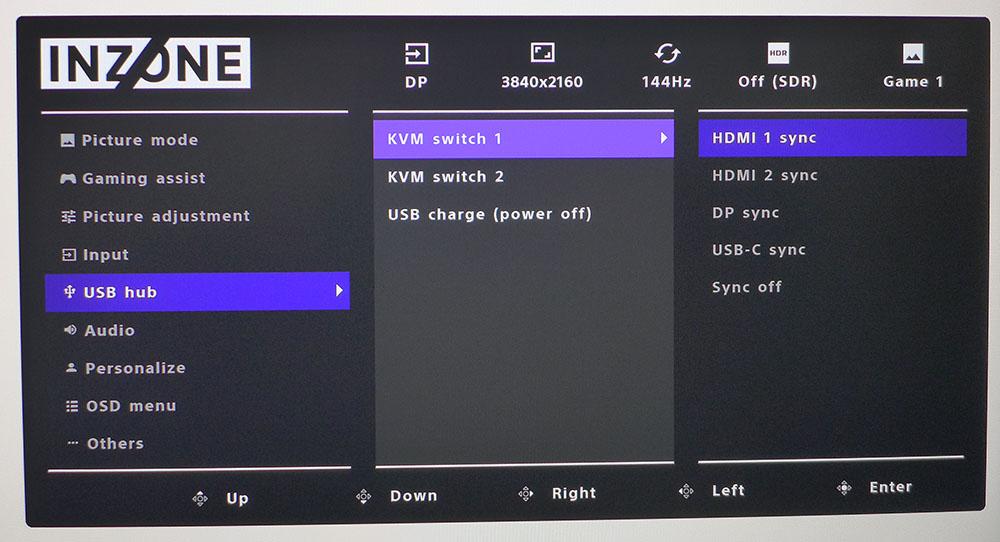
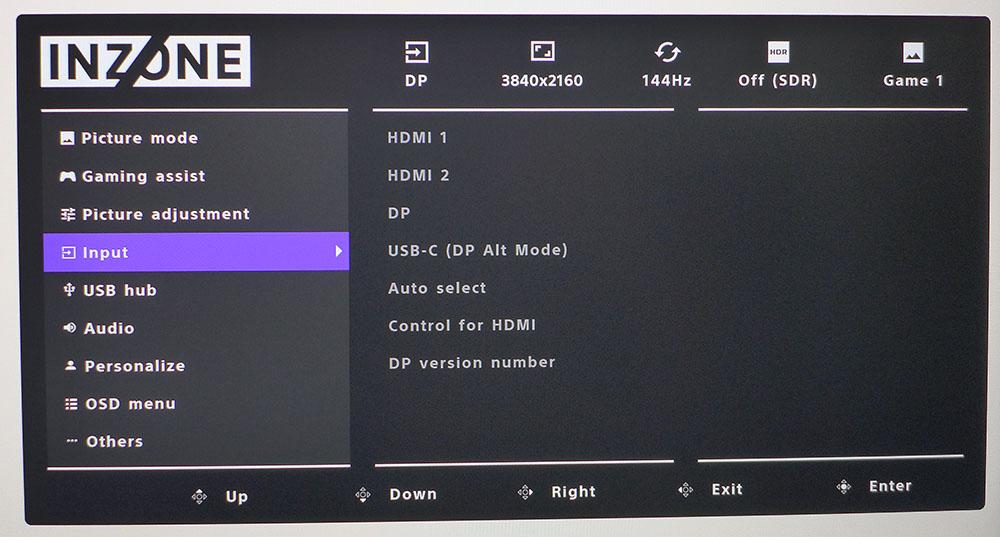

There are five SDR picture modes, of which Cinema is the default. It is very color accurate but has a slightly darkened gamma which some users may prefer. Standard looks a bit lighter in tone and is also color accurate. To calibrate, select one of the Game modes. They unlock a set of gamma presets, color temps and saturation/hue controls. If you turn Auto Picture mode on, the U27M90 will switch to Game 1 when a PS5 is connected.
Gaming Assist includes red and green aiming points, a countdown timer, frame rate indicator, Adaptive-Sync toggle, three-level overdrive and Black Equalizer for exposing hard-to-see shadow detail. The overdrive is best left on its lowest setting. Higher options cause visible ghosting trails behind moving objects.
You can adjust many picture parameters in the two Game modes. Local Dimming has two settings that are more or less aggressive in their operation. I used High to good effect in both SDR and HDR modes. Though there are only 96 dimming zones, the FALD backlight is far more effective in controlling contrast than the edge dimming or backlight modulation found in some other HDR monitors. At this price point, you won’t find a better dynamic range in a 4K display.
The input selector includes a USB-C option, and you can leave auto select on to avoid a trip to the OSD to switch sources. USB-C includes all the features and capabilities of DisplayPort.
The KVM menu assigns the peripherals to one of the four video inputs. This allows the user to use a single keyboard and mouse for multiple systems. You can also set the USB ports to remain active for charging when the monitor is turned off.
The rear LED bar emits a soft glow in one of 14 colors. The only effect is static; you can turn off the light if desired.
Sony Inzone U27M90 Calibration Settings
The U27M90 can be enjoyed without calibration in either Cinema, the default, or Standard modes. No matter your choice, the full DCI-P3 color gamut is employed. I did not find an sRGB option. Cinema has a darker gamma of around 2.3, which helps color look a bit more saturated. Standard sticks to the 2.2 standard and therefore appears a tad lighter. If you want to calibrate, select Game 1 or 2 to unlock gamma, color temp and hue/saturation controls. There is little need for this, but a tiny improvement can be made if you want to satisfy your inner tweaker. My test settings are below. HDR signals lock out all picture controls, but I found it measured very accurately as well.
| Picture Mode | Game 1 |
| Brightness 200 nits | 46 |
| Brightness 120 nits | 28 |
| Brightness 100 nits | 23 |
| Brightness 80 nits | 18 |
| Brightness 50 nits | 11 (min. 8 nits) |
| Contrast | 75 |
| Gamma | 2.2 |
| Color Temp User | Red 100, Green 96, Blue 91 |
Gaming & Hands-on with Sony Inzone U27M90
The U27M90 is Sony’s first desktop computer monitor in a while, but you’d never know that when using it. It is a fully realized product with much to offer, and then some, as a display from one of the top display companies like Asus or Acer. In daily use, it renders the Windows desktop with razor-sharp clarity and beautifully saturated color. Though SDR is technically supposed to be matched with the sRGB standard, today’s wide gamut screens have largely erased that option. The U27M90 doesn’t have an sRGB mode, but that wasn’t a problem for my daily tasks of document editing, spreadsheets or Photoshop work. I left the Local Dimming on high for all SDR content and was rewarded with contrast that rivaled the best VA screens I’ve reviewed.
I settled on my calibrated Game 1 mode for all SDR material. It gave me the best color balance for video and gaming as well as ideal luminance and contrast for all uses. I tried Cinema and found it good for bright video content but a little murky for darker scenes. Its higher gamma value is the culprit there. It was easy to select a darker gamma option in Game 1 mode since the gamma control is available. In Cinema and Standard, it’s not.
Gaming is why we’re here, and I was mightily impressed with the performance. Doom Eternal looked incredibly sharp and tactile in HDR mode. I didn’t have to adjust the in-game sliders to make all detail pop from the brightest highlights to the deepest shadows. The image was vibrant and vivacious, coupled with rich color. Unfortunately, I didn’t have a PS5 on hand, but my PC test system and its GeForce RTX 3090 video card delivered some seriously fun gameplay.
Sony made no missteps in the video processing department. The U27M90’s Adaptive-Sync worked perfectly on both FreeSync and G-Sync platforms. I was able to run G-Sync over HDMI at 120 Hz and DisplayPort at 144 Hz, with HDR in both cases. Frame rates were 120fps and higher, which gave me smooth and responsive motion with no visible artifacts. The overdrive worked perfectly on its lowest setting and showed no distracting blur.
Comparing the SDR and HDR versions of Call of Duty WWII, I found the SDR version looked quite good and easily matched what I’d seen on the best VA screens. The U27M90’s Local Dimming worked flawlessly to deepen black levels and expand contrast to create greater impact. HDR had even broader contrast, of course, with more color saturation. When I fired up an Acer X27 for comparison, it was hard to see a difference between the two images. The Sony gives up about 300 nits peak brightness in HDR mode, but I could not tell in most content. Only the tiniest highlights were slightly brighter on the Acer.
There is no question that Sony has hit a homerun here. The U27M90 easily competes with more expensive FALD-backlight monitors and handily outdistances its similarly priced competition in HDR quality.
Current page: Features and Specificatins
Next Page Response, Input Lag, Viewing Angles and Uniformity
Christian Eberle is a Contributing Editor for Tom's Hardware US. He's a veteran reviewer of A/V equipment, specializing in monitors. Christian began his obsession with tech when he built his first PC in 1991, a 286 running DOS 3.0 at a blazing 12MHz. In 2006, he undertook training from the Imaging Science Foundation in video calibration and testing and thus started a passion for precise imaging that persists to this day. He is also a professional musician with a degree from the New England Conservatory as a classical bassoonist which he used to good effect as a performer with the West Point Army Band from 1987 to 2013. He enjoys watching movies and listening to high-end audio in his custom-built home theater and can be seen riding trails near his home on a race-ready ICE VTX recumbent trike. Christian enjoys the endless summer in Florida where he lives with his wife and Chihuahua and plays with orchestras around the state.
-
waltc3 Here's another one that is fairly unimpressive with HDR nits performance. My 4k Phillips provides ~700 nits SDR--certified 1000 nits HDR--actually supports three separate HDR modes. My last BenQ, 4k provided ~300 nits SDR and about 320 nits HDR (was not certified like this Sony is not certified) and the difference is night and day. Amazing when I consider I paid less for the Phillips than this Sony is retailing for, and the Phillips is a much bigger monitor...!Reply
I also had several Sony CRTs...great monitors--remember my last--a 20" "flat-screened" Trinitron that supported my Voodoo3's 1600x1200 res ROOB....;) As an aside, the ATi fury I bought at the time to test--(the original ATi Fury, not AMD's) would not do 1600x1200 stock! I had call ATi and ask them about it and one of the driver programmers I spoke with (in those days you could dial up practically anyone and actually talk to them!) asked me why I wanted to run at 1600x1200...;) I had to actually add the simple instructions into their driver structure at the time to enable 1600x1200--'cause my Trinitron supported it and I wanted to use it!...;)
Sony made great monitors in those days--they were good enough for me and x86 in those years. The Trinitron brand is well known even today, as you mentioned. Originally, it was the Trinitron TV brand. I'm sure this monitor is a good one, I'm just not enamored of the specs. Those high nits make all the difference, in the display, imo. -
anonymousdude ReplyMakaveli said:Do people fine 27 inch and 4k usable I tried it and found 32 inch to be much better.
For gaming it's fine. Productivity not so much. -
Soul_keeper ReplyMakaveli said:Do people fine 27 inch and 4k usable I tried it and found 32 inch to be much better.
It really is personal preference. I've been using a Samsung U24E590D 23.6" 4K display for a few years now.
Personally I wanted maximum pixel density, good power usage, not too bulky.
Now I think my eyes aren't as good as they once were, I might get a 27" 4K in the future, maybe something like the one reviewed.
27" could be the "sweet spot" for 4K. And greater than 60HZ refresh is a plus.
Also your distance from the screen and usage style play a big role in the decision.
I lean forward and have my face 1' from the screen to read things for example. -
wr3zzz LOL $1000 27" monitor for "PC" gaming, Sony won't even bother supporting adaptive sync for its TV until this year.Reply -
edzieba ReplyIn the 1990s, Sony marketed a line of Trinitron CRT screens. Their main draw was that they only curved on the vertical axis, which meant they were the closest thing to a flat-screen you could buy at the time.
The main draw of Trinitron tubes was their fine phosphor pitch, aligned phosphor grid (matters more for bitmapped graphics and characters than for TV where it produced crisper horizontal and vertical lines) , and lack of shadow masks producing an overall brighter image. Trinitron tubes were available as the normal 'bi curved' surface and as completely flat glass front tubes - as were shadow-mask tubes - so tube curvature was not a deciding factor in their preference. -
hotaru251 4k at 27inches is legit pointless.Reply
waste of energy to power(which costs more in pwoer bill), generates more heat (not what msot ppl want outside of the winter), and lowers frame rate for a near non discernible image quality.
1440p @ 240+ refresh rate would of been a MUCH more interesting product. -
Blacksad999 Reply
That was my thought, also. This is a pretty tough sell at it's price point. It should be $200-300 cheaper, realistically. Otherwise, there are significantly better monitors for the price. Hell, you can get a 48" LG C1 right now for less than this thing, and it's 4k, has amazing HDR, and 120hz.wr3zzz said:LOL $1000 27" monitor for "PC" gaming, Sony won't even bother supporting adaptive sync for its TV until this year. -
gg83 Why isn't Sony using they're OLED tech for gaming monitors? Is it difficult to make OLEDs smaller than 55 inches?Reply -
husker Aside from the resolution to size ratio, they made a huge mistake with the stand. The way the front center leg extends in front of the screen is going to cause some problems and is just an awful design decision. The stand should be functional and out of the way, not sticking out in your face as if to say, "Look at me! I kinda look like a PS5 but I'm just the leg of your stand! Sorry if I'm in the way! Buy a PS5!". Also, apparently computer stands don't know how to judiciously use exclamation marks.Reply
